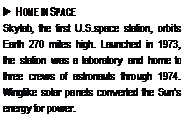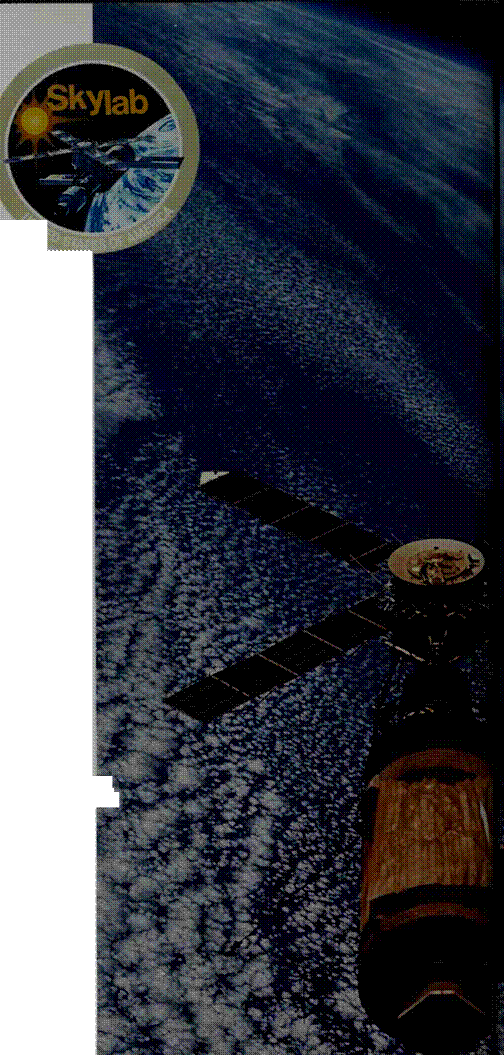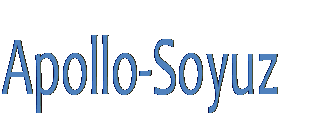Skylab
SKYLAB, the first U. S. space station.
was built after the Apollo missions.
It was launched May 14, 1973. I he size of a small house, Skylab measured 118 feet long. Built from part of an empty Saturn V rocket, it had living and work space for three astronauts, solar panels lor power, and telescopes to study the Sun and Earth.
A “laboratory in the sky,” Skylab s main goal was to learn if astronauts could survive in space for long periods. Three crews lived in Skylab from 1973 to 1974 for up to 84 days. Orbiting the Earth every 93 minutes at 17,000 miles an hour, they ate, slept, and worked in zero gravity, or weightlessness. Because muscles weaken without gravity, they exercised daily. Mission Control constantly monitored their bodies. The tests showed the crews remained healthy. In Skylab, thev performed hundreds of experiments and took thousands of photographs ol the Sun and Earth. Skylab was a big success. Later abandoned, it fell from orbit in 1979.
 |

![]()
 Dinner is Served
Dinner is Served
Skylab’s crew ate a variety of fresh and frozen foods, heated on this warming tray. Forks, spoons, and knives had magnets to keep them from floating away. Food had plastic covers. The crew ate by a window to enjoy the view.

* 4 Space Spider
Can spiders spin webs in the weightless conditions of space? To find out, Skylab took along spider passengers. This spider named Arabella (left) was confused and could not spin well for two days. Then, she adjusted and spun normal webs.
Pulling Power
In the weightlessness of space, human body fluids drift up to the upper body. Astronaut Owen Garriott tests a machine called the Lower Body Negative Pressure experiment. lt corrects the problem by pulling fluids back down to the legs.
|
|
Life on Skylab
Owen Garriott gives fellow astronaut Alan Bean a haircut. A suction hose collects the hair so it won’t float away. At Christmas, Skylab astronauts decorated their space home with a Christmas tree made of food cans.
* Inside Story
A cutaway of Skylab’s orbital workshop reveals its two sections. At top was a laboratory where the crew worked on scientific experiments. Below, the living quarters had a shower, toilet, galley, and eating and sleeping areas.
 |
 N the 1970s, the United States and the Soviet Union began a new period of cooperation. They even agreed to launch a joint space mission, called the Apollo-Soyuz Test Project. In July 19/5, two manned spacecraft took off. One was an American Apollo capsule launched from Florida. The other, a Soyuz capsule, was launched Irom Kazakhstan in the Soviet Union. On July 17, the two capsules met in Earth orbit and successfully docked. They used a specially designed docking module. It lit to the Apollo on one end and to the Soyuz on the other end.
N the 1970s, the United States and the Soviet Union began a new period of cooperation. They even agreed to launch a joint space mission, called the Apollo-Soyuz Test Project. In July 19/5, two manned spacecraft took off. One was an American Apollo capsule launched from Florida. The other, a Soyuz capsule, was launched Irom Kazakhstan in the Soviet Union. On July 17, the two capsules met in Earth orbit and successfully docked. They used a specially designed docking module. It lit to the Apollo on one end and to the Soyuz on the other end.
After docking, the two crews met, shook hands, and visited each other’s ships. 1 hey talked and ate together, and also did experiments in astronomy together. The spacecralt remained docked together for two days. Both returned safely to Earth. With this historic meeting, the two countries began to help each other in using space for peaceful purposes.
![]()
![]()


У "Hello!"
Reaching through the hatch, American astronaut Ihomas Stafford (right) shakes hands with Soviet cosmonaut Aleksey Leonov. Tlie mission symbolized goodwill between the two nations.
A A Toast
Astronauts Thomas Stafford and Donald Slayton celebrate the success of their mission by drinking a toast. The American and Soviet crews exchanged greetings and visited each other’s craft four times before returning home.
< Apollo-Soyuz On Display
Visitors to the National Air and Space Museum can see a replica of the Apollo and Soyuz spacecraft docked with the special docking adapter built for the mission. The display gives a good opportunity to compare U. S. and Soviet spacecraft.











